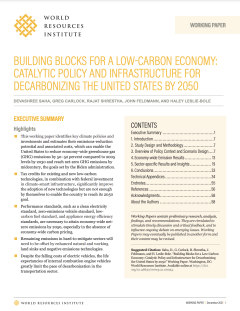
This working paper identifies key climate policies and investments and estimates their emissions-reduction potential and associated costs, which can enable the United States to reduce economy-wide greenhouse gas (GHG) emissions by 50–52% compared to 2005 levels by 2030, and reach net-zero GHG emissions by mid-century, the goals set by the Biden administration.
Decarbonizing the US economy to achieve these goals will require the accelerated deployment of existing low-carbon technologies and new technologies that are not yet commercially available. Federal policies and investments are also needed to drive technology deployment and market transformation, change consumer behaviour, and encourage investment in infrastructure and key technologies needed for a net-zero economy.
This working paper identifies near-term policies and federal investments that can catalyse emissions reductions this decade and set up the US economy for deeper emissions reductions in later decades. The analysis compares the progress toward a net-zero goal offered by different policy packages that overlap and build on one another, which are modeled under three mitigation scenarios. The paper also focuses on the role played by tax incentives, infrastructure investments, targeted spending and sector-specific performance standards as building blocks for a successful decarbonization strategy.
